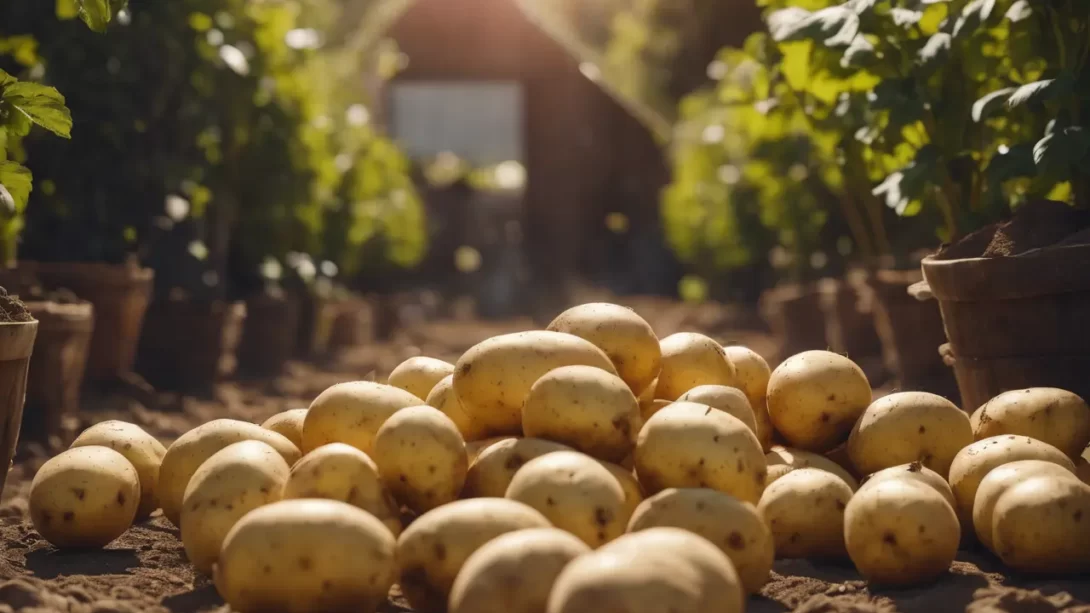Potatoes are a staple in many gardens due to their versatility in the kitchen and relatively easy cultivation process. In USDA Hardiness Zone 7, which encompasses a wide swath of the United States with diverse climates, timing your potato planting correctly is crucial for a successful harvest. This guide provides Zone 7 gardeners with comprehensive insights into planting potatoes, considering the unique climatic conditions of the region.
The Zone 7’s Growing Season
Zone 7 features a moderate climate with a growing season that typically stretches from early spring to late autumn. The average last frost date in the spring ranges from late March to early April, while the first fall frost usually occurs in October. These frost dates are pivotal in determining the planting and harvesting schedule for potatoes, as they are sensitive to both extreme cold and heat. The key is to plant early enough to allow the potatoes to mature before the peak summer heat, yet late enough to avoid frost damage.
Choosing the Right Potato Varieties for Zone 7
Selecting the appropriate potato varieties for Zone 7 can significantly influence the crop’s success. Early varieties like ‘Yukon Gold’ and ‘Red Norland’ are ideal for early spring planting and offer a quicker harvest. Mid-season varieties such as ‘Kennebec’ and ‘Gold Rush’ provide a balance between early and late harvests. For those seeking a later harvest, late varieties like ‘Russet Burbank’ and ‘Canela Russet’ are well-suited to Zone 7’s climate. It’s important to consider the maturity period of each variety and how it aligns with the Zone’s temperature fluctuations.
Optimal Planting Times for Potatoes in Zone 7
In Zone 7, the optimal time to plant potatoes is typically in early to mid-spring. Given the average last frost dates, planting can generally be done safely from mid-March to early April. This timing ensures that the soil is warm enough for potato growth, yet not so late that the plants will suffer in the summer heat. Gardeners aiming for a fall harvest can consider a second planting in late July to early August. This allows for a harvest before the first fall frost and takes advantage of the cooler autumn temperatures.
Soil Preparation and Requirements
Preparing the soil correctly is a critical step in growing healthy potato plants. Potatoes prefer well-drained, loose soil to allow for easy tuber development. In Zone 7, start by testing the soil pH, aiming for a slightly acidic range of 5.0 to 6.5. If necessary, amend the soil with sulfur or lime to adjust the pH level. Incorporate plenty of organic matter, such as compost or aged manure, to improve soil fertility and structure. Good soil preparation ensures adequate drainage and aeration, which are key to preventing potato diseases.
Planting Techniques Specific to Zone 7
When it comes to planting potatoes in Zone 7, the method is just as important as the timing. Begin by cutting seed potatoes into pieces, each with one or two eyes or buds. Allow these cut pieces to cure for a day or two to form a protective skin over the cuts. Plant the seed potatoes about 3 to 4 inches deep and 12 inches apart in rows. Rows should be spaced about 2 to 3 feet apart to provide adequate room for growth. As the potato plants grow, regularly hill soil around the base of the plants. This practice prevents sunlight from reaching the tubers, which can cause greening and make them toxic.
Care and Maintenance During the Growing Season
Once planted, potatoes require consistent care and attention. Water the plants regularly, especially during dry spells, to maintain evenly moist soil. However, avoid overwatering, as this can lead to root rot. When the plants are about 6 inches tall, start the hilling process and continue to hill every few weeks as the plants grow. This not only prevents tubers from being exposed to light but also protects them from pests. Fertilize the plants with a low-nitrogen, high-phosphorus, and potassium fertilizer to encourage strong root and tuber development.
Pest and disease management is also crucial in Zone 7. Watch for common potato pests like Colorado potato beetles and aphids. Diseases such as blight can be a concern, especially in humid conditions. Implement crop rotation, use disease-resistant varieties, and apply organic or suitable pesticides when necessary. Regular monitoring and prompt action can prevent these issues from impacting the yield significantly.
Harvesting Potatoes in Zone 7
Determining the right time to harvest potatoes in Zone 7 is dependent on both the potato variety and the weather conditions. Generally, early varieties can be ready for harvest as soon as 70 to 90 days after planting, while mid-season and late varieties may take 90 to 120 days. Look for signs such as the yellowing and dying back of the foliage, which indicate that the potatoes are maturing. For new potatoes, which are smaller and more tender, you can begin harvesting a few weeks after the plants flower.
When harvesting, use a garden fork or a spade to gently lift the potatoes out of the ground, being careful not to pierce or bruise them. It’s best to harvest on a dry day to reduce the risk of soil clumping and making the process more challenging.
Storing and Preserving Your Potato Harvest
After harvesting, it’s important to cure the potatoes to extend their storage life. Lay them out in a single layer in a cool, dry place away from direct sunlight for about one to two weeks. This process allows the skins to harden, helping the potatoes to store better. Once cured, store the potatoes in a cool, dark, and well-ventilated place. Ideal storage temperatures are between 45°F and 55°F. Avoid storing potatoes in the refrigerator, as cold temperatures can alter their taste and texture.
Troubleshooting Common Potato Growing Issues in Zone 7
Growing potatoes in Zone 7 can sometimes present challenges. Common issues include pest infestations, fungal diseases, and environmental stress. To combat these, practice crop rotation to prevent soil-borne diseases, and choose resistant varieties where possible. If pests are a problem, consider using barriers or organic pesticides as a control method. In cases of extreme heat or drought, ensure consistent watering to keep the plants healthy, and consider using mulch to retain soil moisture.
Conclusion
Planting and growing potatoes in Zone 7 can be a rewarding experience for any gardener. By understanding the best times to plant, preparing the soil properly, and providing the right care throughout the growing season, you can enjoy a plentiful harvest of this versatile and beloved vegetable. Remember, each growing season is an opportunity to learn and improve your gardening skills, so don’t hesitate to experiment and adapt your techniques as you gain more experience. Happy gardening in Zone 7!



